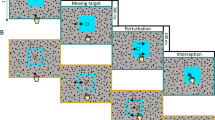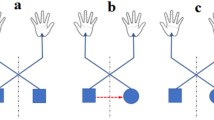Abstract
The presented approach focuses on the attempt to specify strategies of visually organizing sequences of different hand movements and the resulting fine-control of movement close to the target, since in skilled activities our ability to sequence a number of separate movements each having different spatiotemporal characteristics is of central importance. Sequences of different moves have been analysed here. After a gross distance covering part of the move, small correction movements are performed close to the target to reduce the position error. The length of the required correction movements and the corresponding positioning time increase with target distance. In order to investigate motor control strategies two different tasks, with and without time pressure, have been designed. Time pressure forces the subjects to finish the previous move and to prepare the next move simultaneously. Absolute, constant and variable errors revealed that under time pressure the subject changes the control strategy by increasing the constant and reducing the variable error.
Similar content being viewed by others
References
Arnett J, Golby CW, Kay H (1958) The measurement of elements in an assembly task — the information output of the human motor system. Q J Exp Psychol 10:1–11
Beggs WDA, Howarth CJ (1970) Movement control in a repetitive motor task. Nature 225:752–753
Beggs WDA, Howarth CJ (1972a) The movement of the hand towards a target. Q J Exp Psychol 24:448–453
Beggs WDA, Howarth CJ (1972b) The accuracy of aiming at a target: some further evidence for a theory of intermittent control. Acta Psychol 36:171–177
Bizzi E, Abend WK (1985) Control of multijoint movement. In: Cohen MJ, Sturmwasser F (eds) Comparative neurobiology: modes of communication in the nervous system. Wiley, New York
Bock O, Eckmiller R (1986) Goal directed arm movements in absence of visual guidance: evidence for amplitude rather than position control. Exp Brain Res 14:1–8
Bujakas TM (1979) Die Tätigkeit des visuellen Systems bei genauen Handbewegungen. In: Lomow BF, Vergues NJ (eds) Motorische Komponenten des Sehens. VEB Deutscher Verlag der Wissenschaften, Berlin
Carlton LG (1980) Movement control characteristics of aiming responses. Ergonomics 11:1019–1032
Carlton LG (1981) Processing visual feedback information for movement control. J Exp Psychol (Hum Percept Perform)7:1019–1030
Crossman ERFW, Goodeve PJ (1983) Feedback control of handmovement and Fitts' law. Q J Exp Psychol 35A:251–278
Fisk JD, Goodale MA (1985) The organization of eye and limb movements during unrestricted reaching to targets in contralateral and ipsilateral visual space. Exp Brain Res60:159–178
Fitts PM (1954) The information capacity of the human motor system in controlling the amplitude of movement. J Exp Psychol 47:381–391
Fitts PM, Peterson JR (1964) Information capacity of discrete motor responses. J Exp Psychol 67:103–112
Fleischer AG, Becker G (1986) Free hand-movements during the performance of a complex task. Ergonomics 29:49–63
Goodale MA, Pelission D, Prablanc C (1986) Large adjustments in visually guided reaching do not depend on vision of hand or perception of target displacement Nature 320:748–750
Hancock PA, Newell KM (1985) The movement speed-accuracy relationship in space time. In: Heuer H, Kleinbeck U, Schmidt KH (eds) Motor behavior. Springer, Berlin Heidelberg New York
Howarth CJ, Beggs WDA (1985) The control of simple movements by multisensory information. In: Heuer H, Kleinbeck U, Schmidt KH (eds) Motor behavior. Springer, Berlin Heidelberg New York
Howarth CJ, Beggs WDA, Bowden JM (1971) The relationship belween speed and accuracy of movement aimed at a target. Acta Psychol 35:207–218
Keele S W (1968) Movemenl conlrol in skilled motor performance. Psychol Bull 70:387–403
Keele SW, Posner MJ (1968) Processing of visual feedback in rapid movements. J Exp Psychol 77:155–158
Kelso JA (1977) Planning and efferent components in the coding of movement. J Mot Behav 9:33–47
Kelso JAS, Holt KG (1980) Exploring a vibratory systems analysis of human movement production. J Neurophys43:1183–1196
Laabs GJ (1973) Retention characteristics of different reproduction cues in short-term memory. J Exp Psychol 100:168–177
Langolf GD, Chaffin DB, Foulke JA (1976) An investigation of Fitt's law using a wide range of movement amplitudes. J Mot Behav 8:113–128
Laszlo JI, Ward GR (1978) Vision, proprioception and corollary discharge in a movement recall test. Acta Psychol42:477–493
Martenuik RG (1978) The role of eye and head positions in slow movement execution. In: Stelmach GE (eds) Information processing in motor control and learning. Academic Press, London
Morasso P (1981) Spatial control of arm movements. Exp Brain Res 42:223–227
Polit A, Bizzi E (1979) Characteristics of motor programs underlying arm movements in monkeys. J Neurophysiol42:183–194
Prablanc C, Echallier JF, Komilis E, Jeannerod M (1979)Optimal response of eye and hand motor system in pointing at a visual target. I. Spatio-temporal characteristics of eye and hand movements and their relationship when varying the amount of visual information. Biol Cybern 33:113–124
Sanderson FH, Whiting HTA (1978) Dynamic visual acuity: a possible factor in catching performance. J Mot Behav10:7–14
Schmidt RA, Zelaznik HN, Hawkins B, Frank JS, Quinn JT (1979) Motor output variability: a theory for the accuracy of rapid motor acts. Psychol Rev 86:415–451
Schmidt RA, Sherwood DE, Zelaznik HN, Leikind BJ (1985)Speed-Accuracy trade-offs in motor behavior: theories of Impulse variability. In: Heuer H, Kleinbeck U, Schmidt KH (eds) Motor behavior. Springer, Berlin Heidelberg New York
Sheridan MR (1984) Planning and controlling simple movements. In: Smyth MM, Wing AM (eds) The psychology of human movement. Academic Press, London
Stark LS (1968) Neurological control systems. Plenum Press, New York
White CT, Eason RG, Bartlett NR (1962) Latency and duration of eye movements in the horizontal plane. J Opt Soc Am52:210–213
Woodworth RS (1899) Accuracy of voluntary movement. Psychol Rev Monogr [Suppl] 3:1–113
Author information
Authors and Affiliations
Rights and permissions
About this article
Cite this article
Fleischer, A.G. Planning and execution of hand movements. Biol. Cybern. 60, 311–321 (1989). https://doi.org/10.1007/BF00204129
Received:
Issue Date:
DOI: https://doi.org/10.1007/BF00204129




